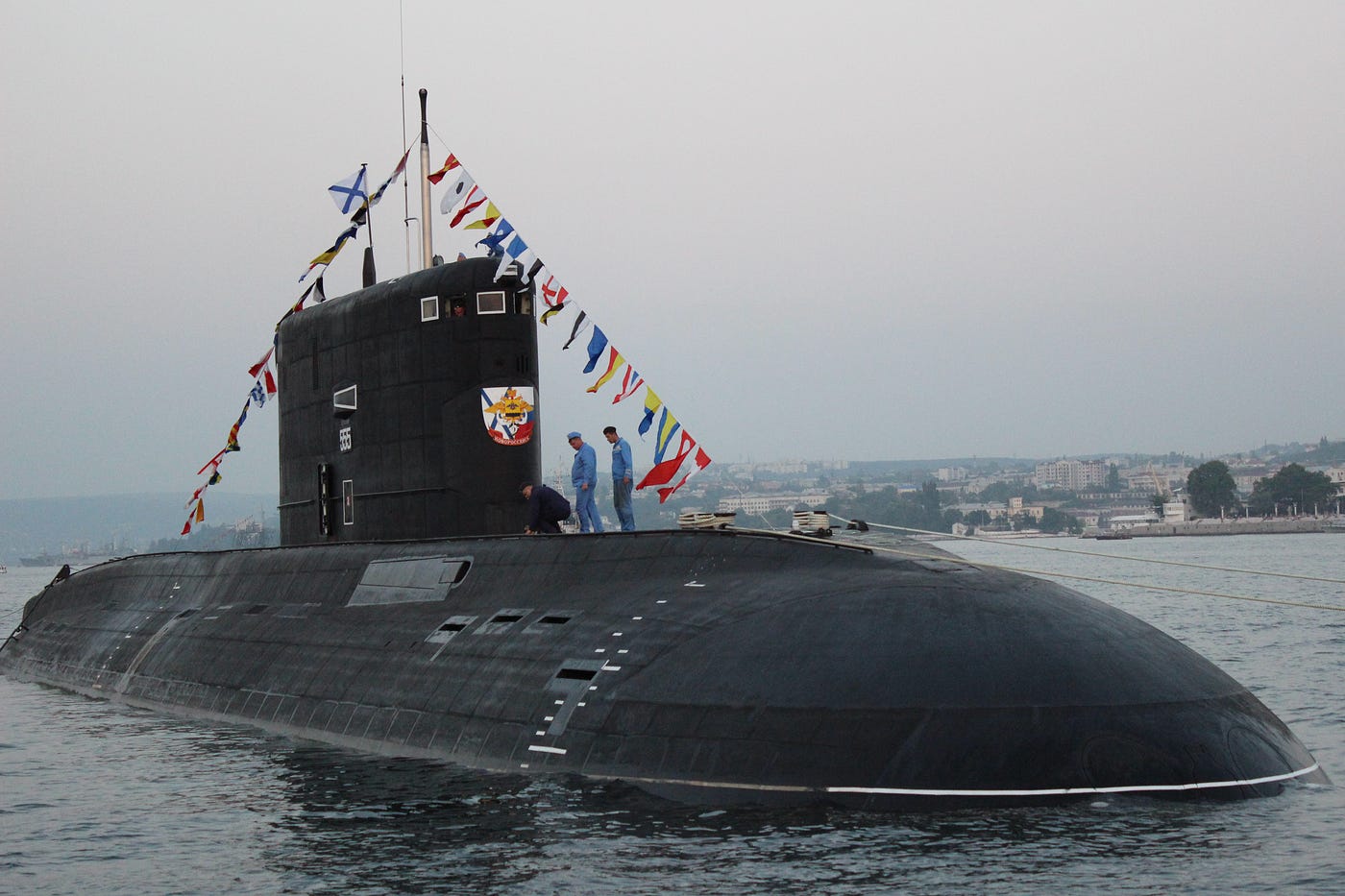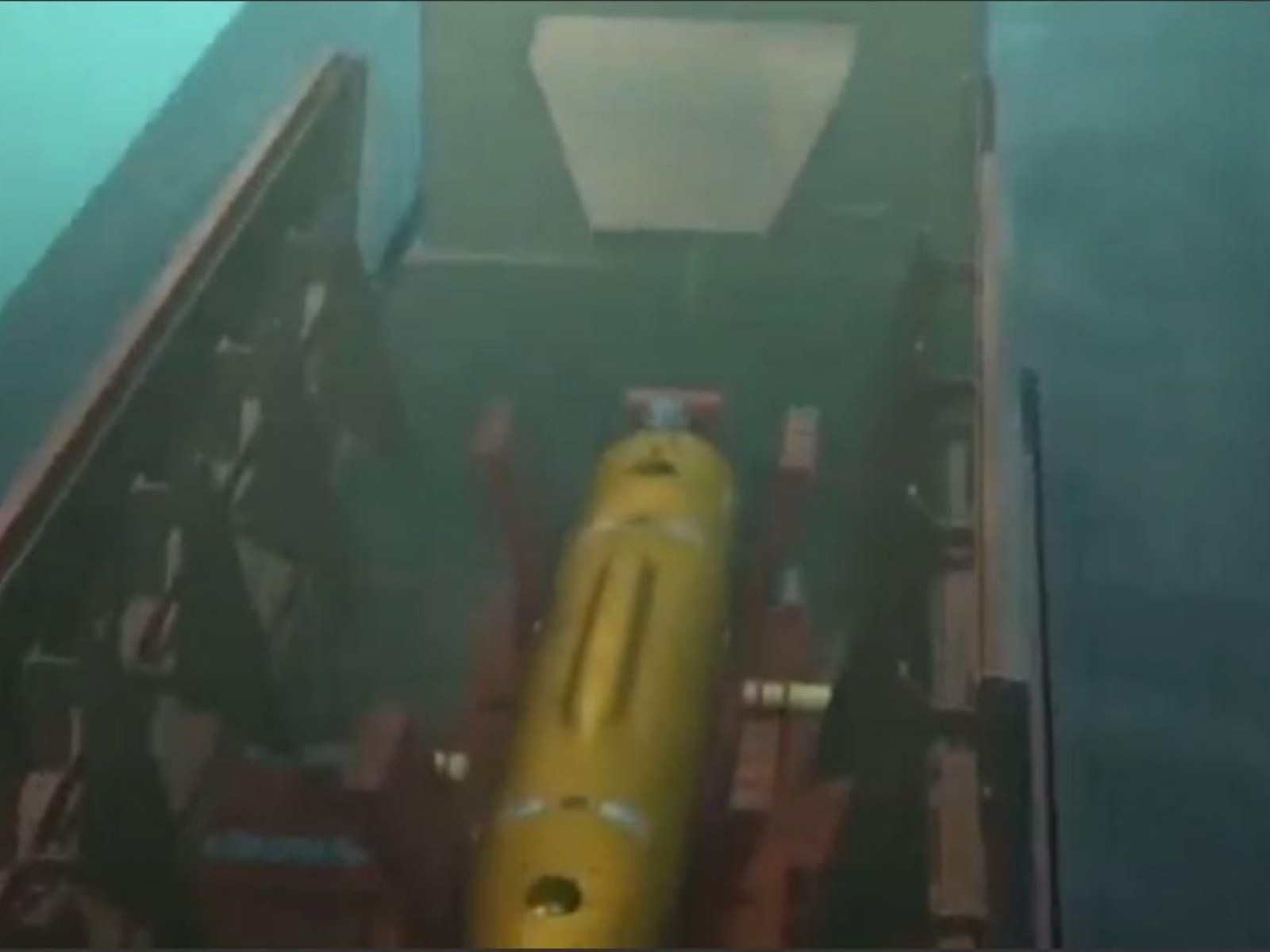Poseidon Russian Torpedo - A Russian Navy submarine armed with a nuclear torpedo the size of a school bus was delivered to the Kremlin this week, according to a statement from the shipyard.
Is based on a Russian Oscar-class guided-missile submarine that has been modified to accommodate six 80-foot Poseidon nuclear torpedoes that can be armed with warheads up to 100 megatons, the USNI said.
Poseidon Russian Torpedo
The submarine was handed over to the Russian Navy in a ceremony at the Northern Fleet headquarters in Severodvinsk on Friday.
Putin 'issues Go Order' For Russia To Attack Ukraine
"The Belgorod submarine opens up new opportunities for Russia to conduct various researches, enables various scientific missions and rescue operations in the most remote areas of the World Ocean," said a statement by the commander of the Russian Navy, Adm. Nikolay Anatolyevich Evmenov.
"The ship is designed to solve various scientific problems, perform search and rescue operations, and can also be used as a carrier for deep-sea rescue and autonomous unmanned underwater vehicles."
The Poseidon, first revealed in 2015, is a strategic nuclear weapon that will have a range of thousands of kilometers and will "destroy vital economic structures of the enemy in coastal areas and cause guaranteed catastrophic damage to the country's territory by creating extensive zones of radioactive contamination. " , making them unusable for military, economic or other activities for a long time," according to a translation of a Russian presentation caught on BBC camera.
Russia has long complained about the strategic imbalance of US missile defense systems in Europe. Poseidon and
Us Observed Russian Navy Preparing For Possible Test Of Nuclear Powered Torpedo
Were created to disable America's ABM advantage by creating a nuclear weapon capable of defeating an American ABM screen.
Is part of the specialized underwater fleet of the Russian Navy, designed for reconnaissance, deep-sea rescue and special operations of the Main Institute for Deep-Sea Research - known by the Russian acronym GUGI, (Главное управление Глубоководных иследование). GUGI boats depart from an isolated arctic station on the Kola Peninsula in the Barents Sea.
Can serve as a mothership for various crews and unmanned submarines for deep-sea missions. These submarines include

(A-12), a manned deep-sea submarine that suffered a battery explosion in 2019 that killed 14 Russian submariners. The Russian Navy is currently repairing the boat, the USNI said earlier.
Putin's 'city Killer' Nuclear Mega Sub With Poseidon Torpedo Spotted On Satellite Pics
While Russia's navy has shrunk significantly since the end of the Cold War, its submarine forces are a pressing concern for the Pentagon.
Russia has launched a new generation of attack submarines armed with long-range cruise missiles capable of striking European capitals from the North Atlantic.
In response to the Russian submarine threat, the Navy reestablished the U.S. 2nd Fleet to establish an anti-submarine warfare command in the Atlantic Ocean. The Russian Navy's Poseidon intercontinental nuclear autonomous torpedo will travel much deeper and faster than submarines. Therefore, new weapon systems are needed to counter it. This article discusses some of the near future systems that NATO may develop.
) for the launched seabed variant) was developed. The simplest explanation is that it is a safeguard against future improvements in missile defense that reduce the reliability of ICBMs (Intercontinental Ballistic Missiles). It is also possible that arms control treaty rules played a role because it is so new that it is not covered by existing treaties except in the most general terms regarding the number of warheads (some deployment restrictions due of the 1972 Underwater Arms Control Treaty is also adopted). Another option is for the weapon to be completely independent of navigation satellites, thereby increasing reliability in another scenario where some or all of the Russian satellites may be lost.
Russia Tests Nuclear 'doomsday' Torpedo In Arctic, Expands Military
However, stealth is unlikely to be a motivating factor. The Poseidon is not a quiet unmanned submarine that can sneak into enemy ports to wreak havoc
Attack without warning. Although it may be described as a "drone" or autonomous underwater vehicle (AUV), it is a weapon. Its mode of operation and route planning are likely to be simple (read
Encompassing both strategic deterrence and tactical nuclear range, this unique multipurpose weapon can be seen as an extremely long-range nuclear-tipped torpedo capable of hitting coastal cities and reportedly also moving targets.

The tactical use of nuclear power, which Russia highlights in promotional videos, makes countering the weapon even more urgent. The use of strategic weapons is currently halted by threats of nuclear retaliation in a policy known as Mutually Assured Destruction (MAD). Therefore, there is no need for a direct counter, and it can be argued that it is counterproductive because it creates a situation where one side has an advantage. This is an argument often made against missile defense; a point that can be demonstrated by the creation of Poseidon itself to offset the development of NATO's anti-missile defenses.
Doomsday' Submarine Armed With Nuclear Torpedoes Delivers To Russian Navy
So if the Poseidon was a purely military weapon, there would be an argument that it wouldn't need a direct adversary. Instead, an indirect countermeasure of a certain retaliatory act of nuclear destruction would suffice. Tactical nuclear weapons, however, are intended for use in conflicts that do not require the use of strategic nuclear weapons against civilian targets. Therefore, some uses of Poseidon cannot be guaranteed to be stopped by MAD and instead require direct countermeasures to mitigate it.
The two countries most likely to see the need to develop direct meters are the United States and the United Kingdom. Both have battlegroups that would be primary targets for Poseidon in tactical mode, and both operate attack nuclear submarines (SSN) whose mission is to directly oppose Russian strategic submarines (SSBN, SSGN). Poseidon receiver submarines will be added to the target list in the future.
Since the 1960s, Western hunter-killer submarines have been designed to stalk Russian submarines close enough to catch them when a conflict erupts and take them out of the equation before they can fire their nuclear weapons. This approach still has some value, but is challenged by the increasing stealth of Russian submarines and the lack of NATO submarines. Continuous tracking of Russian submarines by unmanned surface systems (eg the Anti-Submarine Continuous Tracking Unmanned Vessel (ACTUV)) could also provide a rapid pre-launch kill capability. However, the standalone nature of the Poseidon weapon means that a way must be found to destroy the weapon after launch, even if some or all of the submarines on the launch pad are destroyed within the launch window.
In addition to strategically placed fixed hydrophone arrays, the Navy will need a way to rapidly deploy networks of sensors over the likely path of a Poseidon torpedo. Ideally, the sensor networks would include their own effectors (eg torpedo mines) to minimize the delay from detection to neutralization, as the targets would be moving much faster than conventional underwater targets.
Putin Reveals World's Longest Submarine Packed With Nuclear Torpedoes Capable Of Destroying An Entire City
A) fixed hydrophone array through a water column (general representation). B) fixed my footing. C) Sciatic node. D) surface communication node. E) a torpedo fired at a target. F) The upcoming Poseidon Intercontinental Autonomous Torpedo.
The sensor nets would need to be placed in front of the approaching Poseidon torpedo, as the effectors would likely be too slow to tail the Poseidon. Current reports indicate that the Poseidon can travel at 70 knots, which is close to the limit for normal torpedo-like objects.
Get the ultimate guide to the world's submarines. This secret coastal reconnaissance guide covers over 80 classes of submarines, including all models currently in service with the world's navies. Check it out on Amazon

To achieve fast enough deployment, sensor networks will need to be laid out with planes. Primarily, this applies to large maritime surveillance aircraft (MPA) and underwater helicopters on ships. Ways to deploy the sensor network in the same way as cruise missile submunitions could also potentially be explored, allowing fast jets to deploy a modest sensor network at high speed and range, possibly even in enemy-controlled airspace.
Belgorod: Russia's Giant New Sub Built For Nuclear War
Typically, aircraft use sonar buoys that float and communicate back to the aircraft or land via radio. However, Poseidon's great operating depth means that a network of sensors on the seabed is more sensible and would have the advantage of not drifting apart, thus increasing the network's lifetime, potentially by months or even years.
The challenge in deploying current generations of sensor networks on the seabed from aircraft is that the nodes are connected by cables. This adds weight, drag and risks breakage when laying the net. This can be overcome by the development of underwater wireless communications. Seatooth from WFS can operate in standard audio communication mode, but can also operate in radio frequencies for shorter range low interception and higher frequency data transmission. At very short distances, they can use optical communication for very high data transfer rates. All three modes are included in a single Seatooth node, which also has its own processing capabilities.
Effectors such as powered mines can be integrated into the sensor network using Seatooth wireless technology. The mining nodes will primarily be used to launch the next-generation torpedoes, but they will have standard Seatooth communications and data processing capabilities. Local processing of target information distributed over the network will allow better target detection compared to previous systems and reduce false alarms. Unlike previous generations of land-explosive mines (e.g. Mk.60 CAPTOR), they will be linked together.
They
Russia Launches The World's Longest Nuclear Submarine
Torpedo, torpedo magnets, new russian torpedo, mosquito torpedo, russian super torpedo, torpedo captor, russian torpedo boats, russian rocket torpedo, poseidon, torpedo ipa, torpedo heater, russian high speed torpedo
0 Comments